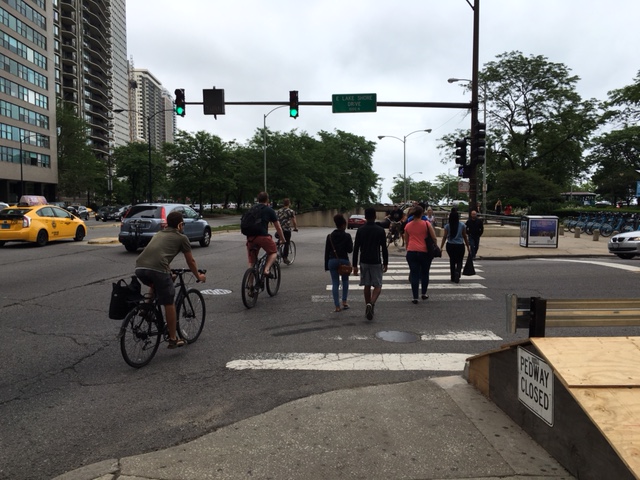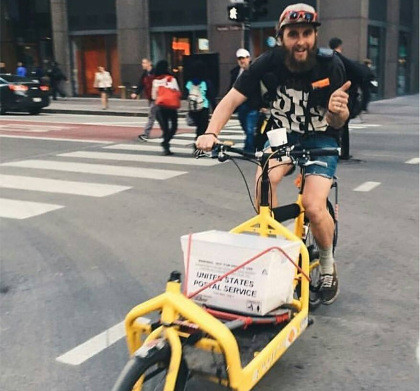I know from personal experience that nothing beats a dip in Lake Michigan after a hard day of bicycle delivery work in hot weather. It appears that on Wednesday evening, bike courier Blaine Klingenberg, 29, was on his way to enjoy that simple pleasure at Oak Street Beach with friends. Tragically, he instead lost his life in a crash with a double-decker tour bus, making him the first bike fatality of 2016.
Yesterday in the late afternoon Klingenberg, who worked at Advanced Messenger Service, posted on Facebook “Who’s down for the lake?”, inviting friends to join him for a cool-off. From the thread, it looks like they decided to head to Oak Street Beach, one of the closest beaches to the Central Business District.
According to authorities, Klingenberg was riding his cargo bike north on Michigan Avenue with a small group of cyclists at around 5:25 p.m. Just south of the underpass to Oak Street Beach, at the intersection of Oak and Michigan, he was involved in a crash with a double-decker tour bus operated by Chicago Trolley & Double Decker Co., which was heading west on Oak.
Klingenberg was trapped under the bus and firefighters had to use airbags to lift the vehicle, according to the fire department. He was transported to Northwestern Memorial Hospital, where has was pronounced dead on arrival.
Advance Messenger owner Bruce Kohn told the Chicago Tribune that Klingenberg had left work about a half hour before the crash. "He was probably the best, nicest bicycle messenger I’ve had the pleasure of working with, and I’ve been doing this my entire adult life," Kohn said. He added Klingenberg was a “cautious” delivery cyclist.
The Chicago Police Department stated that “The victim disregarded the red light at Oak and turned into the bus, causing the fatal collision.” Sadly, but predictably, the comment sections of articles about the crash in the mainstream media quickly filled up with callous remarks blaming Klingenberg for his own death, as well as blanket statements about urban cyclists being reckless and foolish.
However, it’s still not clear how the fatal crash went down. While some witnesses did say Klingenberg rode quickly through a red light, others stated that the bus driver also had a red light, because southbound traffic from Inner Lake Shore Drive had a left-turn signal at the time, the Tribune reported. Major Accidents is investigating the case.
It would be great if online commenters would show some basic humanity towards Klingenberg and his loved ones, instead of rushing to blame the victim. It may turn out to be the case that the cyclist’s actions contributed to his death. However, it must also be pointed out that this is the second time in seven months that a Chicago Trolley bus driver has fatally struck a vulnerable road user on Michigan Avenue.

On November 21, 2015, a Chicago Trolley driver who was turning south onto Michigan from eastbound Monroe Street struck and killed Hiromi Hosono, 42, a professor who was visiting from Ithaca, New York, as she crossed Michigan in the crosswalk with the walk signal. The 49-year-old female driver was cited for striking a pedestrian in the crosswalk. Hosono’s estate filed a wrongful death lawsuit against the bus company in January.
These two deaths raise the question of whether there's something inherently dangerous about huge, double-decker tour buses operating on busy downtown streets. It appears sightlines may have been an issue in the November fatality.
Klingenberg’s death is also a reminder that it’s relatively unsafe and inconvenient to travel between Michgan Avenue and Oak Street Beach – one of Chicago’s most popular beaches -- by foot or bike. At the complex Oak/Michigan/Lake Shore Drive junction, car traffic comes at vulnerable users from several directions. In recent years, the city eliminated two safer routes to the beach for pedestrians by closing underpasses on the east and north sides of the intersection.
This tragedy also highlights the fact that drivers on Michigan are heavily prioritized over pedestrians, cyclists, and CTA bus riders. North and South Michigan avenues, our city’s premier shopping and cultural boulevards, should be safe, efficient, and pleasant to travel by walking, biking, and transit.
Instead, Michigan is a six-lane highway with no dedicated lanes for buses or bikes. As an example of how car-centric the street is, when north-south traffic on Michigan gets a green light, dozens of people walking north and south on the west side of the street are forced to wait an additional phase while a handful of motorists get a left-turn signal.
And downtown alderman Brendan Reilly underscored the fact that Michigan is a dangerous place to bike when he vetoed the installation of Divvy stations along the corridor three years ago. He argued that most Divvy users would be afraid to ride in the street, so they’d pedal on the sidewalk, creating a hazard for pedestrians.
Obviously, all road users should take responsibility for their own safety, and that of others. But as the Active Transportation Alliance recently pointed out, the onus for preventing crashes lies most heavily on those operating multi-ton vehicles on our streets.
Let’s stop arguing about what Klingenberg could or couldn’t have done to prevent himself from being fatally struck by the bus driver. Instead, let’s talk about what we can do to prevent more deaths of vulnerable road users on Michigan Avenue in the future.
Update 6/16/16, 5:30 p.m.: Friends have launched a GoFundMe page to raise money for Klingenberg's funeral expenses.
Fatality Tracker: 2016 Chicago pedestrian and bicyclist deaths
Pedestrian: 13 (seven were hit-and-run crashes)
Bicyclist: 1





